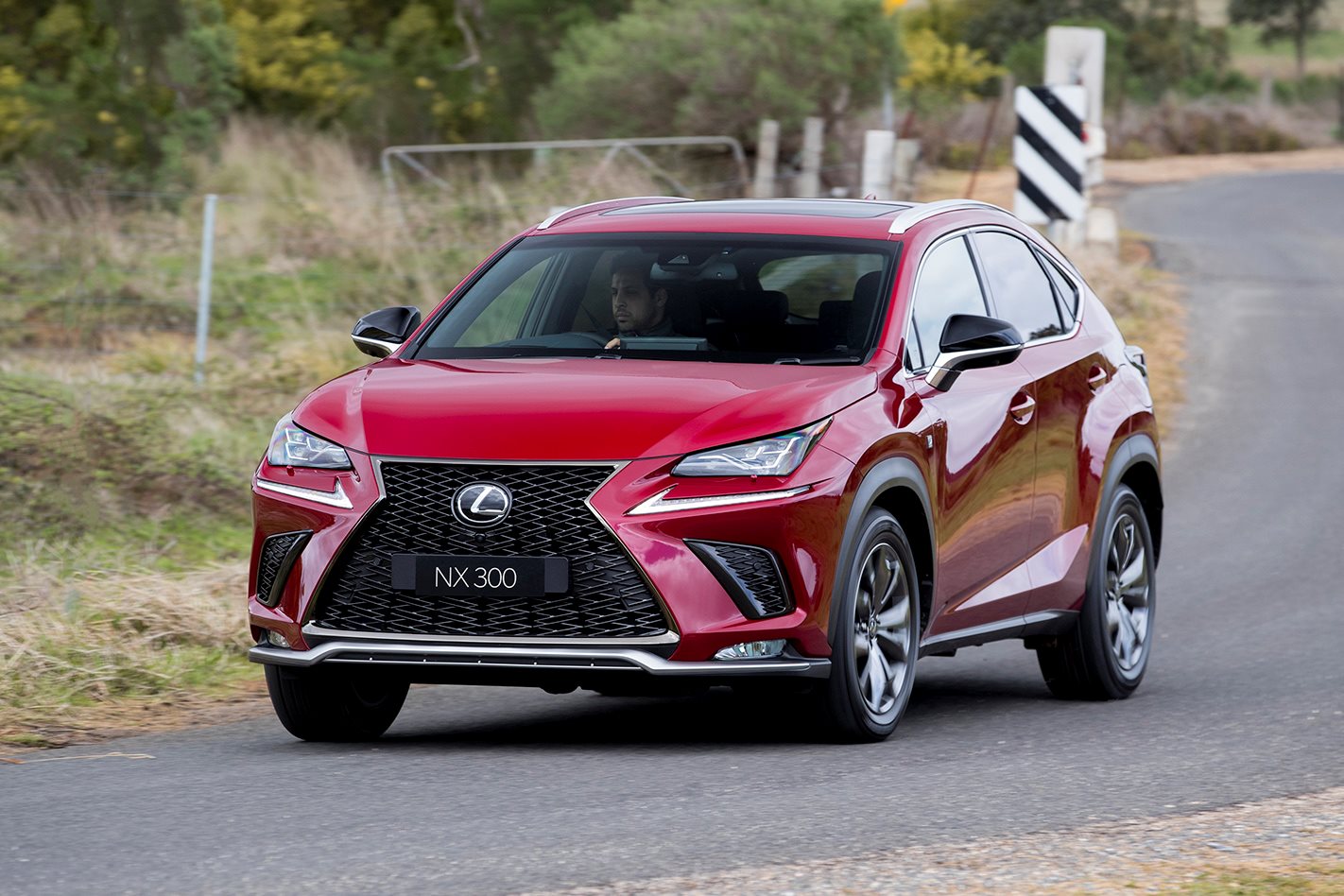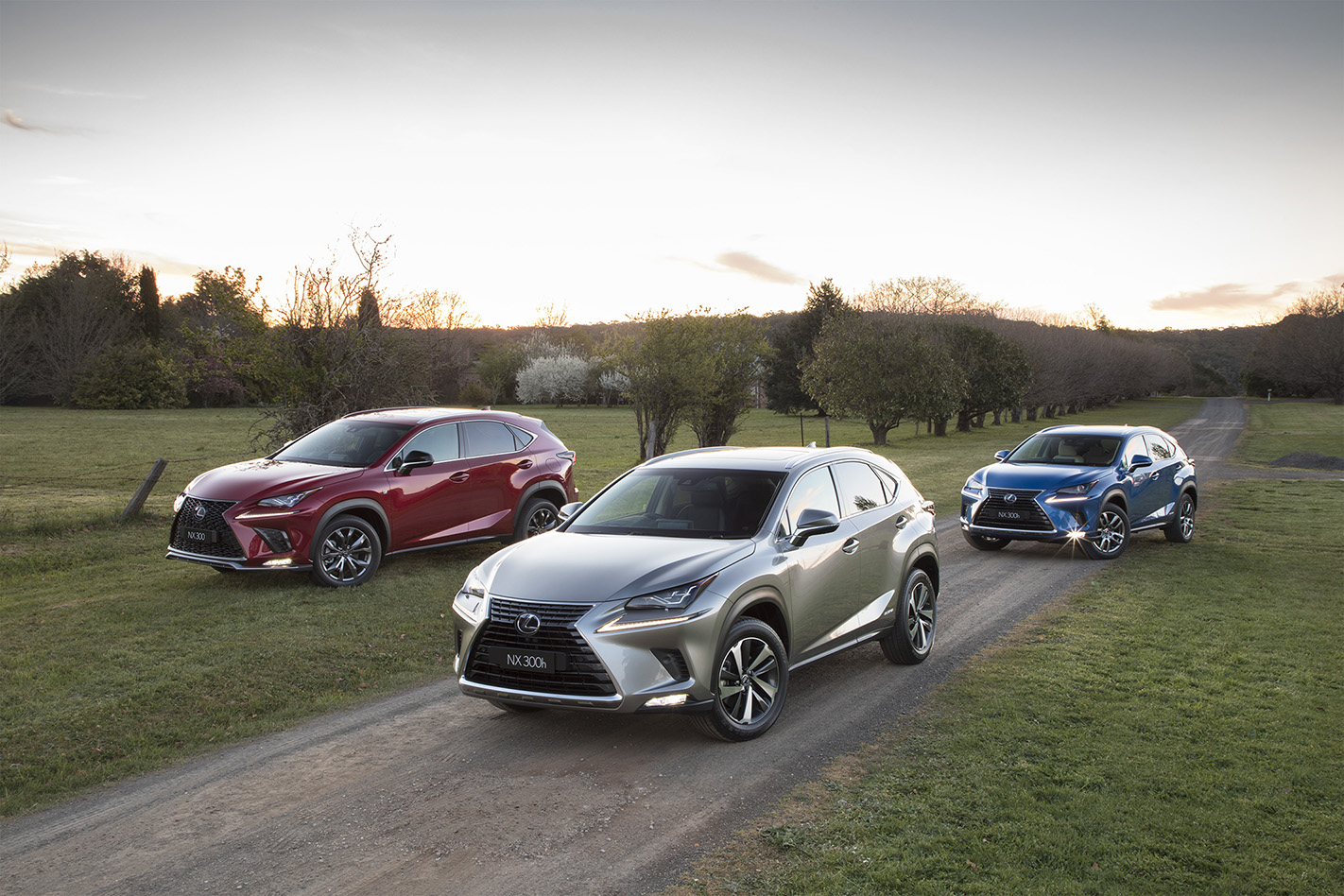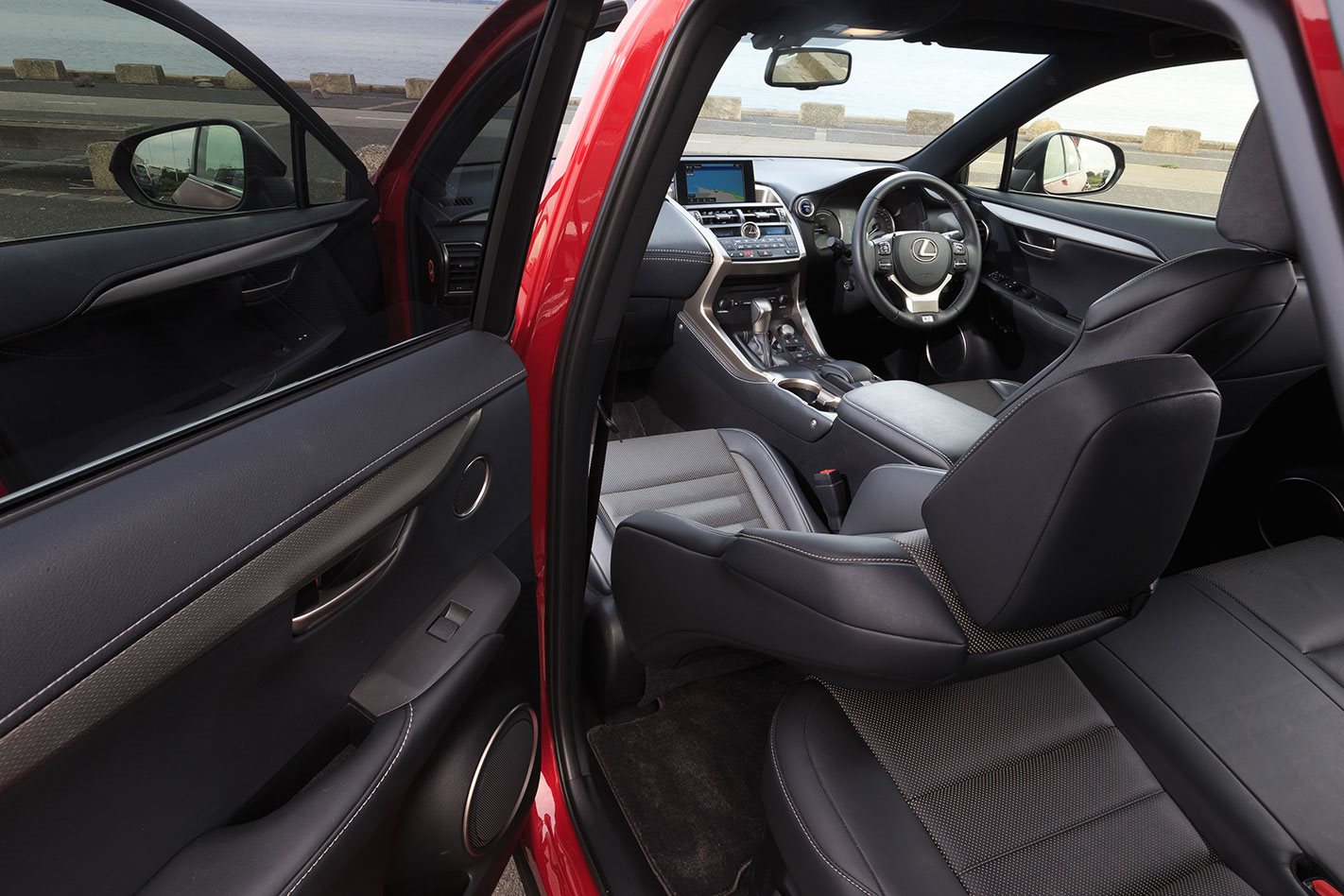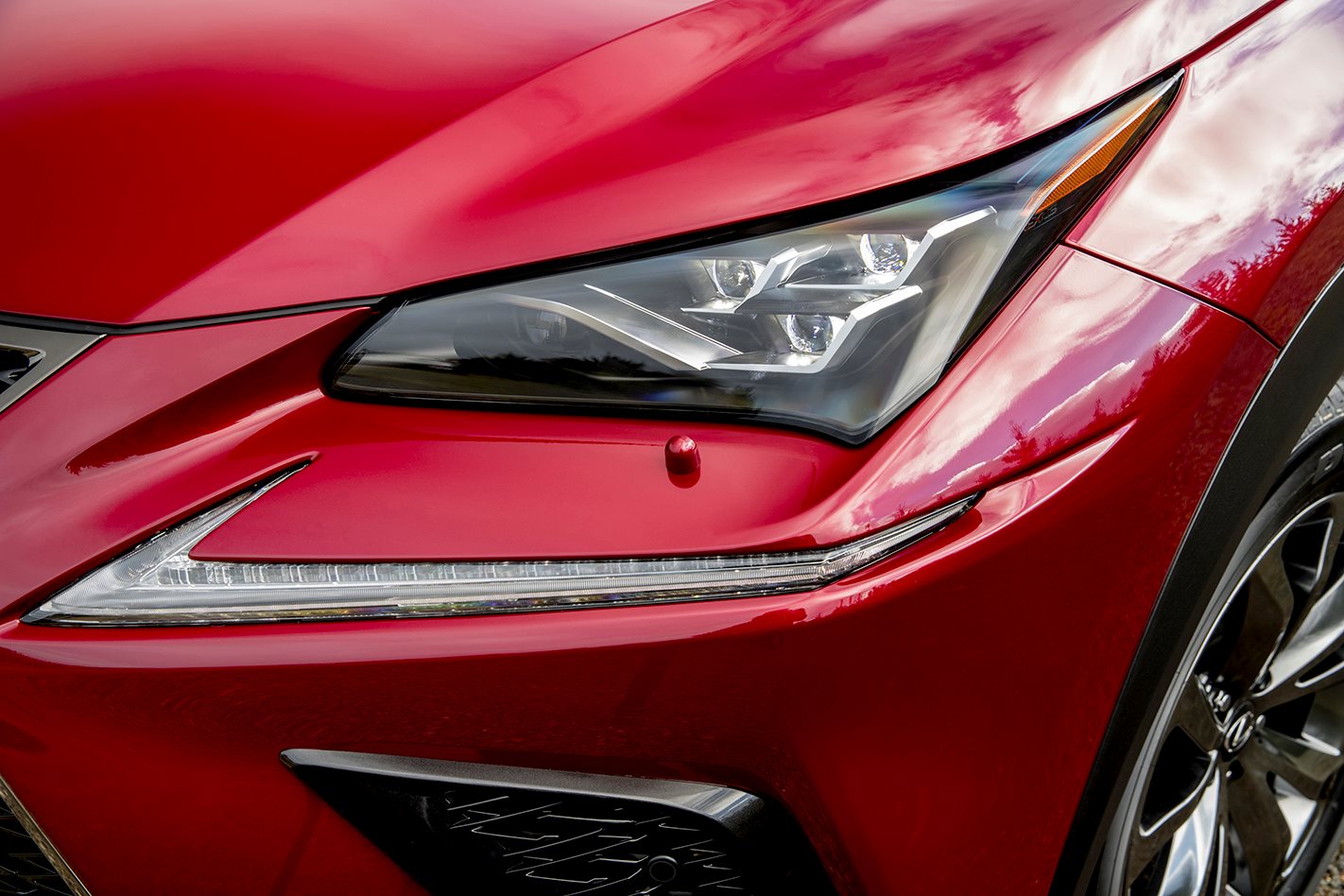
Score breakdown
Things we like
- Sumptuous interior
- Smooth turbo-petrol engine
- Hybrid option
Not so much
- Cosy cabin
- No diesel
What stands out?
The Lexus NX is a distinctive looking medium SUV with a richly appointed interior, a great reputation for reliability, and a four-year warranty. You can have a smooth turbo-petrol engine, or a petrol-electric hybrid. All-wheel drive is available, and autonomous emergency braking is standard.

What might bug me?
Driving under 80km/h on the space-saver spare tyre, until you can fix your full-sized flat.How bumpy roads have become since you got your NX, and especially if you ordered one of the more expensive F-Sport or Sport Luxury trims. These replace the conventional suspension used on less costly NX models with more sophisticated, but unfortunately less comfortable, adaptive dampers.
What body styles are there?
Five-door SUV-type wagon only.The Lexus NX drives either the front wheels or all four wheels, depending on the version.
The all-wheel-drive systems used in the NX are on-demand systems. Most of the time, they drive the car through the front wheels, saving fuel. But they drive the rear wheels also, automatically, when that’s helpful.The NX is classed as a medium SUV, higher priced.
What features does every Lexus NX have?
- Driver assistance including adaptive cruise control and autonomous emergency braking – which Lexus calls Pre-Collision Safety System (PCS) – lane-keeping assist, road-sign assist, blind-spot monitoring
- 10.3-inch multimedia screen with satellite navigation and live traffic updates.
- A reversing camera, and parking sensors front and rear (these help you judge how far the bumpers are from obstacles).
- A 10-speaker audio system with dual USB inputs, digital radio, and Bluetooth for phone calls and audio streaming. A Remote Touch controller on the centre console, which lets you navigate phone, audio, navigation and other functions.

- Keyless entry and start (which lets you unlock the car and drive away without removing the key from your pocket or bag).
- Automatic transmission, with paddle shifters.
- Dual Zone Climate Control Air Conditioning
- Rain-sensing windscreen wipers, automatic high-beam and self-dimming mirror.
- Heated and power-adjusted front seats
- A drive mode select system with eco, comfort and sports settings, which lets you adjust how eagerly the engine and gearbox respond to your right foot.
- Tyre pressure monitor, which warns you if a tyre has lost air.
- Bright, long-lasting LED headlights with washers.
- LED daytime running lights and fog lights with cornering lights.

- Eighteen-inch wheels made from an alloy of aluminium, usually lighter and better looking than the steel wheels with plastic covers found on some lower-priced cars. A space-saver spare wheel and tyre.
- Power-operated tailgate, rear spoiler and roof rails.
- Illuminated door handles and puddle lights.
- Hill-start assist and trailer sway control.
- Eight airbags: two directly in front of the driver and front passenger; one alongside each front occupant to protect the upper body; a curtain airbag down each side protecting the heads of front and rear occupants; a knee protection airbag for the driver; and a cushion airbag in the base of the front passenger’s seat near the front of the cushion, to help hold you in position during a crash.
- Electronic stability control, which can help you control a skidding car. All new cars must have this feature.
Which engine uses least fuel, and why wouldn’t I choose it?
The 2.5-litre, four-cylinder, petrol-electric hybrid in the NX300h uses the least fuel on the official test, consuming about 5.7 litres/100km (city and country combined).One reason you might not choose the hybrid is that you plan to use your Lexus mainly on long drives in the country. The NX300h relies on deceleration to charge the battery that powers its electric motor, and it gets much more of that around town. In steady cruising, its fuel use will approach that of similar non-hybrid cars.
Another is that you would rather pay less for your Lexus NX, while getting more power. The less costly NX300 uses the alternative engine, a 2.0-litre turbo-petrol four-cylinder. It offers about 20 percent more power than the NX300h when you work it hard – say, when overtaking. But it will use a lot more fuel around town, with a combined test figure of 7.7 litres/100km.The NX300h has a continuously variable transmission (CVT), which does away with fixed gear ratios and responds steplessly to the driving conditions. The NX300 has a conventional six-speed automatic.
What key features do I get if I spend more?
The NX300 and NX300h each come in three versions: Luxury, F-Sport and Sports Luxury. The least costly is Luxury, which has a leather-like synthetic seat trim and the equipment found in any Lexus NX. You can have front-drive only, or all-wheel drive – the more expensive F-Sports also offer FWD or AWD, while Sports Luxury versions are AWD only.
Paying more for an F-Sport gets you:
- Interior cosmetic touches include aluminium alloy control-pedal covers and door-sill scuff plates, while outside you get sportier looking bumper bars, front grille and wheels.
- Sport+ and Custom drive modes
- The power-adjusted front seats on an NX F-Sport can be cooled (as well as heated)
- Driver’s seat adjustment memory, which makes it easy to restore your setting after a companion has driven the car.
- Bolstered front seats with adjustable headrests, and driver’s seat lumbar support.
- Part-leather seat trim.
- Sports steering wheel.
- Wireless phone charger.
- Multi-element LED headlights dip only part of their high beams for oncoming vehicles, retaining full illumination to either side.
- 360-degree panoramic view monitor, which gives you a bird’s eye view of the car to help you park in tight spaces.
- AWD as standard.
- Power-operated sunroof.
- Heated rear seats that power-fold.
- Cabin trim that substitutes woodgrain highlights for the F-Sport’s metallic look.
- 14-speaker Mark Levinson branded sound system.
- Head-up display lets you check speed without taking your eyes from the road.
Does any upgrade have a down side?
Choosing the hybrid NX300h brings some unusual driving traits. In particular, its brakes feel unresponsive when you first press the pedal, then become more powerful quite sharply as you press harder. This is a symptom of the hybrid’s brake energy regeneration system, which uses energy from your slowing the car to help charge the battery that drives the electric motor.Moving from an NX Luxury to an NX F-Sport or Sports Luxury brings you a feature Lexus describes as Adaptive Variable Suspension. The Adaptive suspension has the capacity to adjust how softly or firmly the NX rides, depending on road condition, how you are driving, and the drive mode you choose.
Not all exterior colours are equal: some are designated Premium and cost about $1000 extra.
How comfortable is the Lexus NX?
The sumptuous NX interior pampers you, and while it is smaller than most alternatives, that lends a cosy and cossetting – rather than claustrophobic – feel to the cabin. (The relatively compact proportions do mean less space to stretch out for those in the back, however).The stitching and trim on the dashboard, door trims and the seats themselves (be they the real leather versions) is beautiful to behold and lovely to touch. The steering wheel is nicely sculpted, and the front seats are supportive and comfortable.
The layout of the buttons, such as for the climate control and driver aids, seems fussy and disorganised at first, but familiarity breeds ease. Nevertheless, WhichCar testers find the ‘remote touch’ infotainment interface on the centre console difficult to use.The NX shuts out tyre, suspension and wind noise well. The ride of an NX Luxury may feel a bit firm and sharp around town but on the highway it is quite good.The Adaptive suspension in the NX F-Sport and Sports Luxury (revised for the 2018 model year) supplies a more brittle ride than you get in an NX Luxury.
What about safety in a Lexus NX?
A reversing camera, front and rear parking sensors, tyre pressure monitors, anti-lock brakes, the mandatory stability control and eight airbags contribute to an impressive standard safety package in the Lexus NX.Augmenting this on every NX is an active safety suite comprising auto emergency braking, lane keeping assistance, a blind-spot monitor and a rear cross-traffic alert.Two of the eight airbags are placed directly in front of the driver and front passenger. One alongside each front occupant to protects the upper body. There is a knee-protection airbag for the driver, and a cushion airbag in the nose of the front passenger’s seat to help hold you in position during a crash. Finally, a curtain airbag down each side of the car protects the heads of front and rear occupants from side impacts.The auto-braking on an NX works at speeds up to 180km/h, drawing on radar and camera-type sensors to scan the roadway ahead. It recognises pedestrians at up to 80km/h. If it detects a collision risk, it will warn you. If you don’t act on the warning, it will brake automatically.Lane keeping assistance alerts you if you begin to stray distractedly into a neighbouring lane – and can even start to steer you back onto your own part of the road. It can operate even where the left side of the road is unmarked.The blind-spot monitor makes it safer for you to rely on your exterior mirror when changing lanes, while a rear cross-traffic alert helps you avoid embarrassing (and sometimes dangerous) crashes when backing out of parking spaces and driveways.The Australasian New Car Assessment Program (ANCAP) awarded the Lexus NX its maximum five stars for safety, most recently in October 2017.
I like driving – will I enjoy this car?
With its angular headlights and tail-lights and an hourglass front grille, the NX looks sporty and even avant-garde alongside its reserved European alternatives.Climb into the cabin and that impression stays with you. Like the others, it is a luxury car, but its personality feels slightly different and more extroverted.The NX300h has hybrid quirks that may endear it to some but will irritate others. The first – perhaps equally a peculiarity of its CVT auto – is the appearance of a delayed response to the accelerator pedal. You hear a faint whine from the electric motor and a rising note from the petrol engine before the car builds much speed. Similarly, the brakes do not seem to slow you much at first, but they get more powerful quickly as you depress the brake pedal further (a characteristic connected with their role in charging the hybrid drive system).
The flip side is that driving the NX300h smoothly, and allowing the regenerative system to capture kinetic energy by planning your acceleration and braking, brings a satisfying feeling that you are making progress efficiently.The NX200t offers more traditional driver appeal. It’s more powerful, and lighter. The conventional six-speed automatic makes it easier to take control of the engine, which also sounds nicer and spins freely. Paddle gear shifters on the steering column and the Sport+ driving mode in the more expensive versions add the enjoyment.
However, even the NX300 isn’t as much fun to drive as alternatives such as the Audi Q5 and Land Rover Discovery Sport. In corners, its attitude is not easily adjusted with the steering, throttle or brakes, and the steering wheel doesn’t deliver a great sense of connection with the road. And if you drive any NX version enthusiastically, the electronic stability control system is quick to curtail the adventure.Stiffening of the suspension about November 2017, for the 2018 model year, improved handling as intended. But the NX remains short on dynamic polish by comparison with several strong European alternatives.The all-wheel-drive system fitted to most NX versions aids stability on wet or otherwise slippery roads and helps you make progress in muddy or snowy conditions. However, the NX is not built to tackle rough tracks or off-road – and if you were to get a puncture you would have only the skinny space-saver spare tyre.
How is life in the rear seats?
Not as spacious as it is in most alternatives. For a medium SUV the Lexus is narrow with a short wheelbase, which means its rear passengers have less shoulder and leg room. Space aside, however, the Lexus looks after occupants quite well.There are dedicated air-conditioning vents, and a fold-down armrest. The seatback angle is well judged, and there’s good under-thigh support. Foot room and headroom are pretty good also. And just as it is in front, it’s quiet in the rear compartment.
How is it for carrying stuff?
The Lexus NX can squeeze in as much cargo as some alternatives but significantly less than others, such as the BMX X3. The luggage bay expands to 1545 litres with the rear seatbacks folded, and they split 60-40. Tie-down points and metal scuff plate on the loading lip are nice touches.
The standard powered tailgate opens when you press a button on the key fob or on the tailgate. It can be programmed to open to a specified height – so that it does not foul a low roof, for example.
Where does Lexus make the NX?
The Lexus NX is made in Japan.
What might I miss that similar cars have?
If you will do a lot of long-distance driving, perhaps a turbo-diesel engine. Many medium SUV alternatives have a diesel option. A turbo-diesel in a similar package will give a longer highway range between refills.The ability to integrate your smartphone with the car’s touchscreen, via Apple CarPlay or Android Auto, so that you can display and control phone apps with the screen. This is available in most of its luxury and mainstream rivals.Among other premium medim SUVs worth considering are the, Audi Q5, Mercedes-Benz GLC-Class, Land Rover Discovery Sport, and BMW X3, Volvo XC60, or the smaller Lexus UX.
Are there plans to update the Lexus NX soon?
The Lexus NX300h arrived in October 2014, and the NX200t in early 2015.About November 2017, the NX received a facelift and significant upgrade, which extended auto braking and other active safety features to all NXes (previously this was standard on Sports Luxury, and an option on F-Sport). The NX200t was renamed the NX300, and all trim levels also received active cruise control, LED headlights, a bigger, 10.2-inch touchscreen, revised interior trim, and modified suspension aimed at improving handling.
In July 2019, Lexis introduced a special-edition NX Crafted that added additional features and was available with both powertrains and a choice of front- or all-wheel drive.The NX is derived from the previous-generation Toyota RAV4, and given the RAV4’s age we expect a short model cycle and an all-new NX before the turn of the decade.
I like this car, but I can’t choose which version. Can you help?
We like the NX300 Luxury. The turbocharged NX300 is a more enjoyable drive than the NX300h, and it costs less. And its passively damped suspension is more comfortable to ride on than the active suspension in the more expensive F-Sport and Sports Luxury.
Score breakdown
Things we like
- Sumptuous interior
- Smooth turbo-petrol engine
- Hybrid option
Not so much
- Cosy cabin
- No diesel



